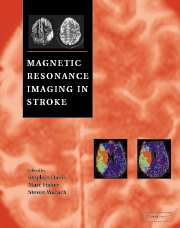
-
Select format
-
- Publisher:
- Cambridge University Press
- Publication date:
- August 2009
- March 2003
- ISBN:
- 9780511544927
- 9780521806831
- Dimensions:
- (276 x 219 mm)
- Weight & Pages:
- 1.313kg, 280 Pages
- Dimensions:
- Weight & Pages:
You may already have access via personal or institutional login
Book description
Magnetic resonance imaging provides non-invasive information about the brain's blood flow, water movement and biochemical abnormalities following stroke, and advances in magnetic resonance imaging (MRI) are transforming the investigation and treatment of cerebrovascular disease. Echoplanar techniques with diffusion and perfusion weighted imaging, together with developments in magnetic resonance spectroscopy and angiography, are replacing CT scanning as the diagnostic modality of choice. In this profusely illustrated book world leaders in these technologies review the scientific basis and clinical applications of MRI in stroke. It will appeal to a broad readership including stroke physicians, neurologists, neurosurgeons, rehabilitation specialists, and others with a clinical or research interest in cerebrovascular disease.
Reviews
‘This book provides a good overview of the use of MRI in stroke and is of educational benefit to both clinicians and radiologists involved in the care of patients with stroke and has started to take on some very important issues …’
Source: Neuroradiology
'This is an excellent intermediate level textbook that covers the topic of MR imaging in stroke and ischaemic stroke in particular. The book is well written throughout and easy to read. … The authorship reads like a Who's Who of the literature of stroke imaging and the quality of this book reflects it. … I would thoroughly recommend this book to all trainee physicians, neurovascular surgeons and neuroradiologists with an interest in ischaemic stroke …'
Source: Acta Neurochirugica
Contents
Metrics
Full text views
Full text views help Loading metrics...
Loading metrics...
* Views captured on Cambridge Core between #date#. This data will be updated every 24 hours.
Usage data cannot currently be displayed.
Accessibility standard: Unknown
Why this information is here
This section outlines the accessibility features of this content - including support for screen readers, full keyboard navigation and high-contrast display options. This may not be relevant for you.
Accessibility Information
Accessibility compliance for the PDF of this book is currently unknown and may be updated in the future.


